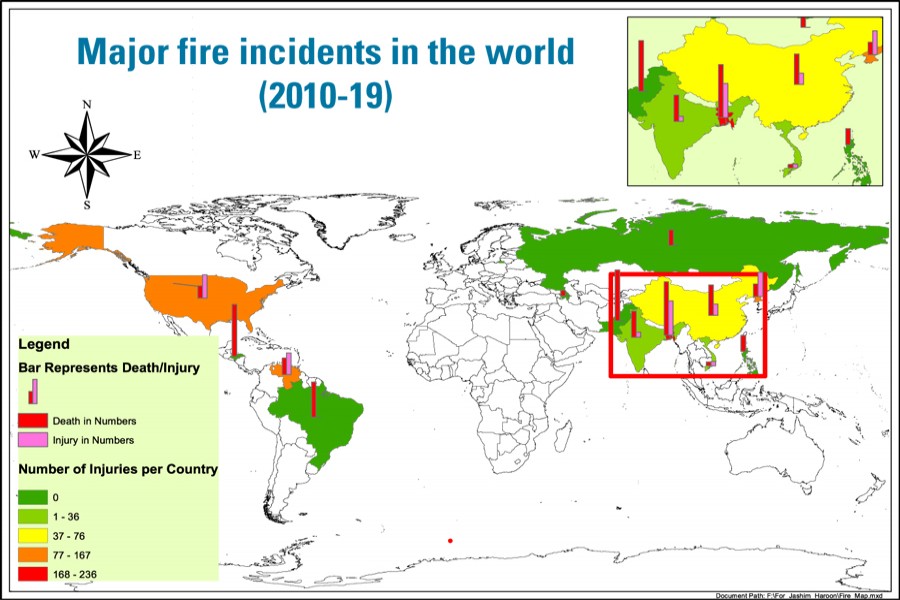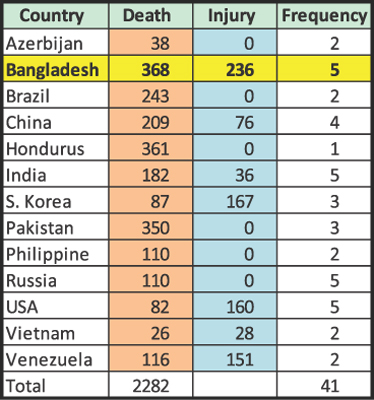
Bangladesh topped the list of deaths in major "structure fire" incidents in the world in the last one decade since 2010, according to Wikipedia.
A structure fire is a blaze involving the structural components of different types of residential, commercial or industrial buildings.
 Residential buildings range from single-family detached homes and townhouses to apartments and tower blocks, whereas various commercial buildings range from offices to shopping malls.
Residential buildings range from single-family detached homes and townhouses to apartments and tower blocks, whereas various commercial buildings range from offices to shopping malls.
The Financial Express (FE) compiled the data pertaining to major building fire incidents posted on the online encyclopaedia.
The death toll from five big structure fire incidents rose to 368 in Bangladesh in the last one decade.
It is followed by Honduras, where a prison fire mishap killed 361 inmates in 2012. The fire occurred on February 14-15, 2012 at the National Penitentiary in Comayagua.
But the actual death toll in all types of fire incidents would be much higher than 368 in Bangladesh during the period under review, said people at the Department of Fire Services.
The data analysis shows that three South Asian countries -- India, Pakistan and Bangladesh- -- have higher numbers of such casualties.
The advanced nations like the USA, Russia and England and developing nations like China also experienced a significant number of such incidents, but the number of deaths remained low there.
During the period under review, a total of five major fire incidents took place in Bangladesh, of which two including Thursday's Banani fire occurred in less than three months.
They are the Nimtoli fire incident that happened in 2010, the Ha-Meem fire in 2010, Tazreen Fashion fire in 2012, Chawkbazar fire in 2019, and FR Tower fire in 2019.
The first building fire took place in the country in March 2009 at Bashundhara Shopping Mall in the city, the encyclopaedia shows.
Experts said Bangladesh's unplanned rapid urbanisation was the key reason behind such incidents.
They maintained that large-scale reform was needed for bringing discipline in building construction.
Mubasshar Hussein, an architect and urban planner, told the FE that necessary laws were there, but there was a lack of enforcement.
"I don't understand how FR Tower was developed as a 22-storey building, as RAJUK approved it as an 18-storey building," said Mr Hussein, also the president of Commonwealth Association of Architects.
Dhaka has several well-planned modern sections and some excellent modern architecture, but "there are many unplanned buildings also," he added.
Iqbal Habib, another architect, told the FE that the fire-related death toll could be minimised through having comprehensive fire-fighting systems in the high-rise buildings.
The advanced nations maintain three types of such systems - fire alarm, fire escape, and fire fighting.
"In my opinion at best 10 buildings will be found in the city, which duly maintain such requirements to fight fire incidents," said Mr Habib, also an environmentalist.
"I was involved with the interior design work of a high-rise building in Gulshan area. Three multinational companies that rented its floors forced the building owner to install those facilities."
Mr Habib suggested formation of a compliance committee under the city corporations to address the situation right now.
The committee would inspect the buildings and issue certificates, which would be renewed each year.
"We hope we will be successful in implementing such a compliance initiative, as we did almost the same thing for (the garment factories following pressure of) the international buyers after the Rana Plaza disaster," he added.
In 2016, the population was 18.237 million in greater Dhaka, which is one of the most populated cities in the world. It has the density of 23,234 people per square kilometre within a total area of 300 square kilometres.
At present there are over 1,500 high-rises in the city, and many are under construction.
The City Centre at Motijheel is currently the tallest building in Dhaka as well as in Bangladesh with a height of 171 metres (561 ft).
© 2024 - All Rights with The Financial Express
